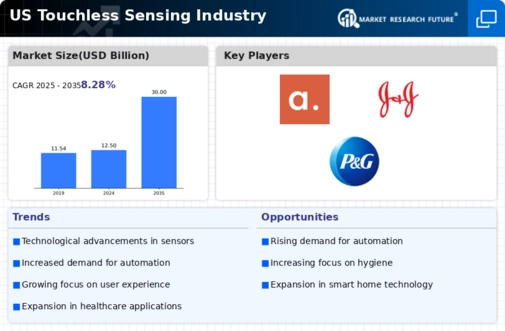Rising Demand for Hygiene Solutions
The touchless sensing market is experiencing a notable surge in demand for hygiene solutions across various sectors. This trend is particularly pronounced in environments such as hospitals, restaurants, and public facilities, where minimizing contact is essential for health and safety. According to recent data, the market for touchless technology in hygiene applications is projected to grow at a CAGR of approximately 15% over the next five years. This growth is driven by heightened awareness of cleanliness and the need for solutions that reduce the spread of germs. As consumers and businesses prioritize health, the touchless sensing market is likely to expand, offering innovative products such as automatic faucets, soap dispensers, and hand sanitizing stations. The increasing focus on hygiene is thus a critical driver for the touchless sensing market, influencing product development and adoption rates across various industries.
Regulatory Support for Touchless Technologies
Regulatory support is emerging as a crucial driver for the touchless sensing market. Governments and regulatory bodies are increasingly recognizing the importance of touchless technologies in promoting public health and safety. Initiatives aimed at encouraging the adoption of touchless solutions in public spaces, transportation, and healthcare facilities are gaining momentum. For instance, regulations mandating touchless systems in certain environments are likely to boost market growth. This supportive regulatory landscape is expected to contribute to a projected market growth rate of around 8% over the next few years. As regulations evolve to favor touchless technologies, the touchless sensing market is poised to benefit, driving innovation and expanding its applications across various sectors.
Increased Focus on Automation and Smart Solutions
The touchless sensing market is benefiting from an increased focus on automation and smart solutions across various industries. Businesses are increasingly adopting touchless technologies to streamline operations, enhance user experiences, and improve efficiency. For instance, in retail, touchless payment systems are becoming more prevalent, allowing customers to complete transactions without physical contact. This shift towards automation is expected to propel the market forward, with estimates suggesting a growth rate of approximately 10% over the next few years. The demand for smart solutions that integrate touchless sensing capabilities is likely to drive innovation and investment in the market, as companies seek to enhance their operational capabilities and meet evolving consumer expectations.
Technological Advancements in Sensing Technologies
Technological advancements are playing a pivotal role in shaping the touchless sensing market. Innovations in sensor technologies, such as infrared, ultrasonic, and capacitive sensors, are enhancing the accuracy and reliability of touchless systems. These advancements enable more sophisticated applications, from smart home devices to industrial automation. The integration of artificial intelligence and machine learning with touchless sensing technologies is also gaining traction, allowing for improved user experiences and operational efficiencies. As a result, the market is projected to witness a growth rate of around 12% annually, driven by the increasing adoption of smart technologies. The continuous evolution of sensing technologies is thus a significant driver for the touchless sensing market, fostering new applications and expanding market reach.
Growing Consumer Preference for Contactless Experiences
Consumer preferences are shifting towards contactless experiences, significantly impacting the touchless sensing market. As individuals become more accustomed to technology that minimizes physical interaction, the demand for touchless solutions is on the rise. This trend is evident in various sectors, including hospitality, where touchless check-in and room controls are becoming standard. Market Research Future indicates that approximately 70% of consumers express a preference for contactless options in their daily interactions. This growing consumer inclination is likely to drive the development and adoption of touchless technologies, as businesses strive to meet these expectations. The touchless sensing market is thus positioned to capitalize on this trend, fostering innovation and expanding its reach across multiple sectors.















Leave a Comment